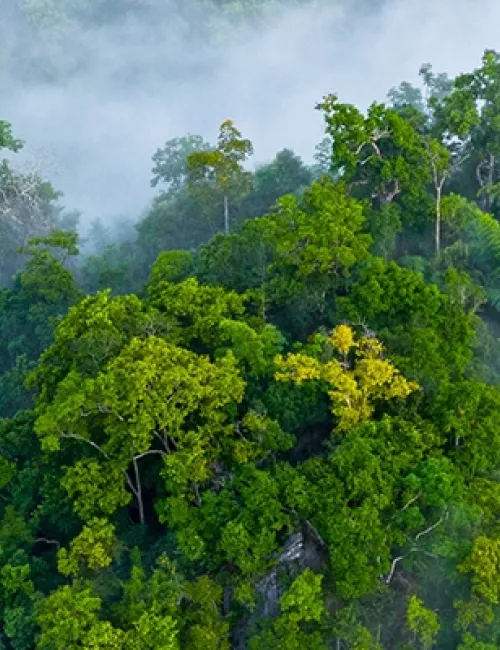Biomes of Brazil – resilience, recovery and diversity (BIO-RED) helped to improve understanding of the extent to which Brazilian forest and savanna are resisting climate extremes, the extent to which destruction is reversible, and the vulnerabilities of intact and modified vegetation to climate extremes.
Our work
This project spanned the three largest biomes in Brazil, the Atlantic and Amazon Forests, and Cerrado savanna, covering >85% of Brazil's territory and include many of the most diverse ecosystems on Earth. While the value of their vegetation is increasingly recognised it is unclear to what extent these systems can regenerate or resist the increasing environmental stressors associated with climate change, particularly heating & drying.
BIO-RED aimed to understand how these changes affect the ability of intact and regenerating ecosystems to deliver societal benefits. This requires addressing these key questions:
- How resilient are old-growth & regenerating ecosystems to the key stressors expected from future environmental changes?
- Is the destruction a reversible process on time-scales relevant to human society? Thus, will vegetation recover to a similar state as the original and provide similar services?
- Will the increasingly hot climate affect the recovery of forests and will modified forests be more vulnerable to future environmental change than intact forests?
BIO-RED builds on existing observational networks, focused on three focal-landscapes, in W Pará (Amazon forest), E Mato Grosso (cerrado), and E São Paulo (Atlantic forest), each well sampled by our plot infrastructure and so ideal for intensive work to probe processes and to scale-up via hyperspectral imaging.
Publications
- Bauters, M., Grau, O., Doetterl, S. … Malhi, Y. et al. 2022. Tropical wood stores substantial amounts of nutrients, but we have limited understanding why. Biotropica, 54(3): 596–606. doi: 10.1111/btp.13069
- Davies, S.J., Abiem, I., Abu Salim, K. … Malhi, Y. et al. 2021. ForestGEO: Understanding forest diversity and dynamics through a global observatory network. Biological Conservation, 253: 108907. doi: 10.1016/j.biocon.2020.108907
- Esquivel-Muelbert, A., Phillips, O.L., Brienen, R.J.W. … Malhi, Y. … Matias de Almeida Reis, S. et al. 2020. Tree mode of death and mortality risk factors across Amazon forests. Nature Communications, 11, 5515. doi: 10.1038/s41467-020-18996-3
- Aguirre-Gutiérrez, J., Oliveras, I., Rifai, S. et al. 2019. Drier tropical forests are susceptible to functional changes in response to a long-term drought. Ecology Letters, 22(5): 855–865. doi: 10.1111/ele.13243
- Elias, F., Ferreira, J., Lennox, G.D., Berenguer, E. et al. 2019. Assessing the growth and climate sensitivity of secondary forests in highly deforested Amazonian landscapes. Ecology: Ecological Society of America, 101(3): e02954. doi: 10.1002/ecy.2954
- Doughty, C.E., Santos-Andrade, P.E., Shenkin, A. … Malhi, Y. et al. 2018. Tropical forest leaves may darken in response to climate change. Nature Ecology & Evolution, 2: 1918–1924. doi: 10.1038/s41559-018-0716-y
- Burton, C. Rifai, S. and Malhi, Y. 2018. Inter-comparison and assessment of gridded climate products over tropical forests during the 2015/2016 El Niño. Philosophical Transactions of the Royal Society B: Biological Sciences, 373: 20170406. doi: 10.1098/rstb.2017.0406
- Bruelheide, H., Dengler, J., Purschke, O. … Blonder , B. et al. 2018. Global trait–environment relationships of plant communities. Nature Ecology & Evolution, 2: 1906–1917. doi: 10.1038/s41559-018-0699-8
- Berenguer, E., Malhi. Y., Brando, P. et al. 2018. Tree growth and stem carbon accumulation in human-modified Amazonian forests following drought and fire Philosophical Transactions of the Royal Society B: Biological Sciences, 373: 20170308. doi: 10.1098/rstb.2017.0308
- Aragão, L.E.O.C., Anderson, L.O., Fonseca, M.G. … Berenguer, E. … Malhi, Y. et al. 2018. 21st Century drought-related fires counteract the decline of Amazon deforestation carbon emissions. Nature Communications, 9: 536. doi: 10.1038/s41467-017-02771-y

